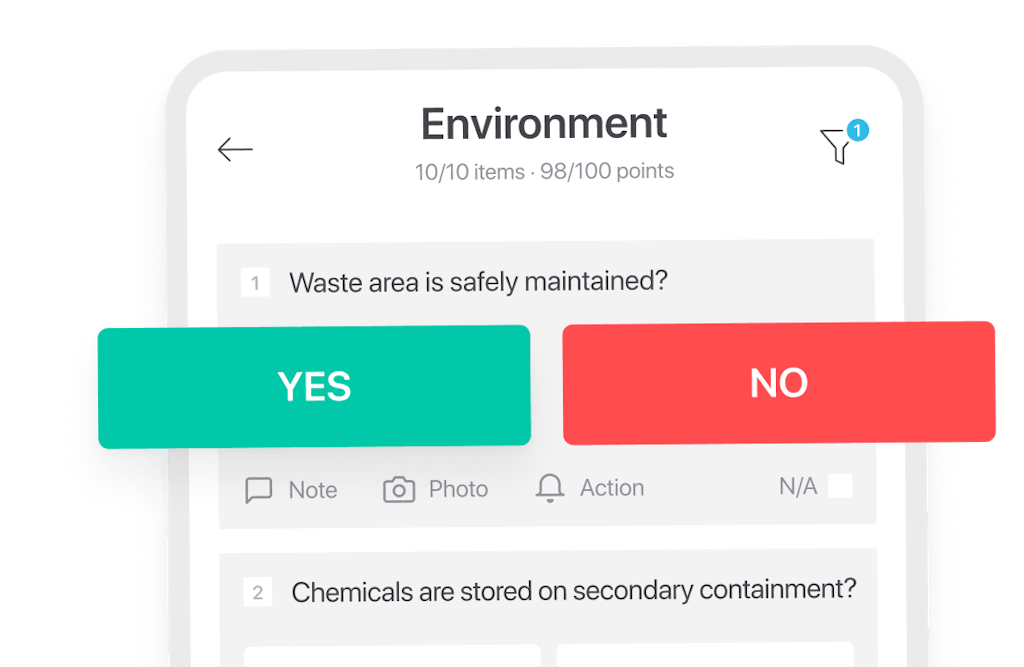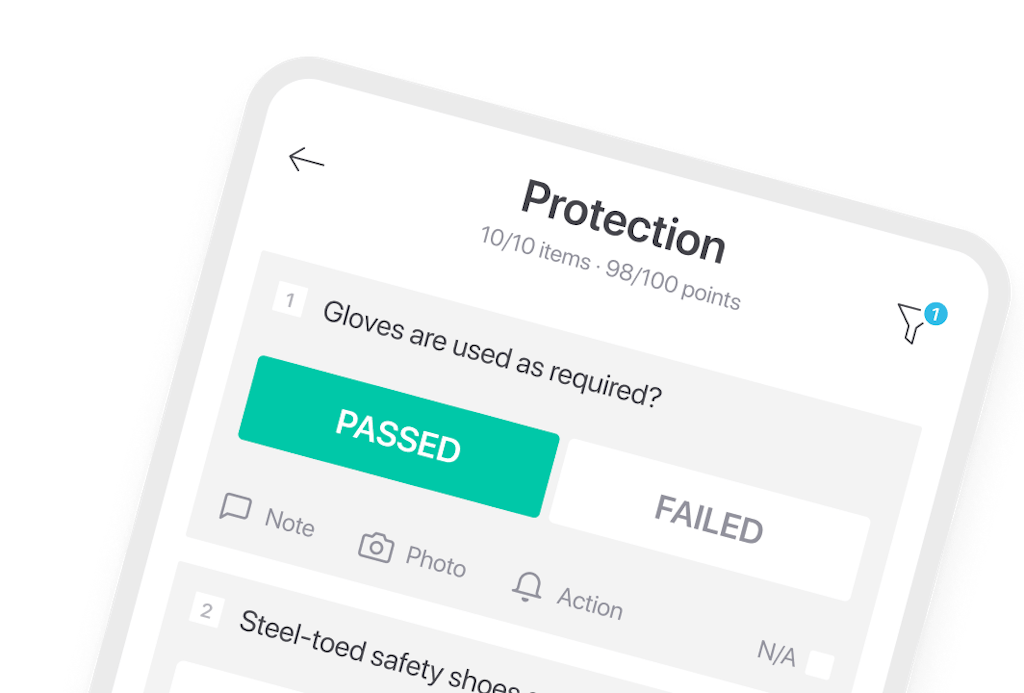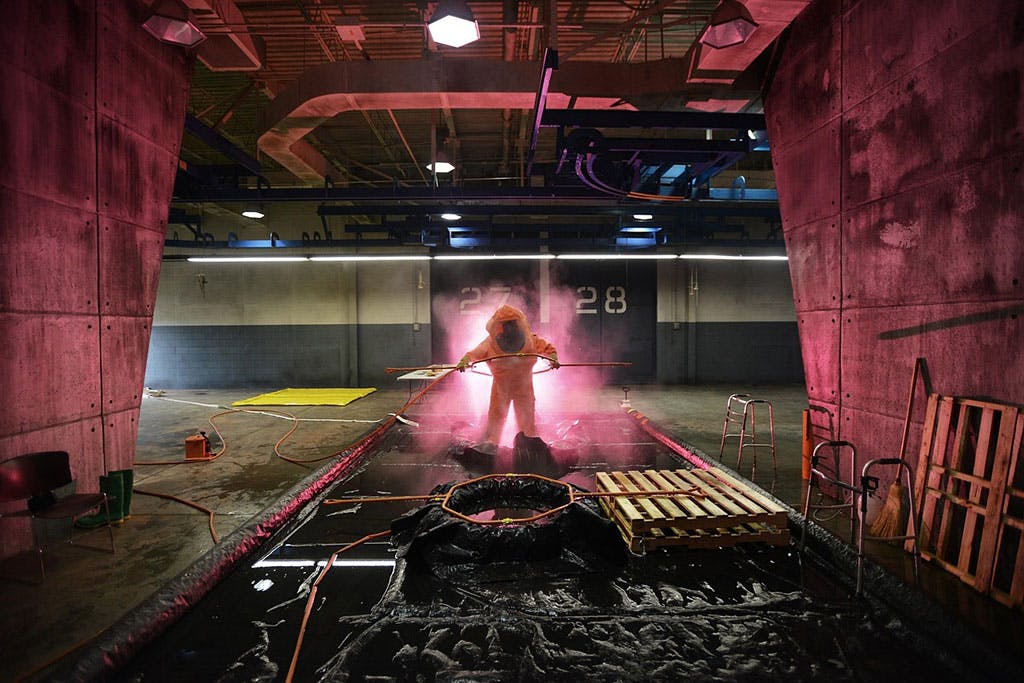No matter the type of work we do, no matter the circumstances – we all deserve a secure working environment. Whether you are a business owner or an employee, it is important for you to know how to recognize these possible hazards around your office.
That’s why we created this comprehensive OSHA Hazard Assessment checklist:
Identify & assess common office safty hazards!
Download this comprehensive OSHA Hazard Assessment checklist and prevent workplace injuries, illnesses, and accidents.

We explain the hazards in detail below.
- About Workplace Safety
- What Are Workplace Safety Hazards?
- About Workplace Safety Fails
- 10 Common Safety Hazards in the Office
- 1. Illnesses
- 2. General Injuries
- 3. Mishandling
- 4. Soreness or Pain
- 5. Transportation Incidents
- 6. Assaults
- 7. Electrical Accidents
- 8. Eye Strain
- 9. Tirendess
- 10. Exposure to Toxins
- How Can You Reduce The Chance of Workplace Safety Fails?
About Workplace Safety
Apart from the most important, but obvious reason, workplace safety is a very important topic due to its impact on the business itself.
Any possible injuries, any possible malfunction or incident reporting, simply costs the company (due to missed working days or even paid penalties) and puts it at risk of additional workplace safety inspections, which can lead to the closing of the business. All of these can also affect the quality of the business, causing both internal and external problems.
In the U.S., the institution that is responsible for all health and safety issues in a workplace is the U.S. Department of Labor, or rather its three agencies. In this article, we will focus mostly on top 10 common office hazards, and this falls under the jurisdiction of OSHA: Occupational Safety and Health Administration.
What Are Workplace Safety Hazards?
Although hazard is quite a strong word (meaning something that is likely to cause damage), it’s important to look at it not as a certain outcome, but rather as a red flag signaling something that can be prevented. Every workplace that focuses on mitigating these safety hazards will increase loyalty among their employees as well as their customers.
OSHA divides workplace safety failures (office hazards included) into the following categories:
Chemical
Chemical working environment safety fails include any dangerous and unsupervised contact with potentially harmful chemicals (those that can impact health and/or safety of workers). Exposure to these chemicals can create short term or long term harm, cause damage of different scales, and even death.
To put things in perspective:
One of the most common chemical health (and thus safety) hazards was once tobacco smoke – which is why it is now banned in all places of business.
Physical
Physical workplace safety fails include anything that might bring damage to the physical wellbeing of the worker, like actions causing injuries. These fails are the most common type of all office hazards as it is very difficult to prevent all possible causes (for example, a simple broken mug in the office can cause a serious cut on a person’s hand).
Biological
A biological workplace safety hazard comes from an organism that can cause threat to the worker’s wellbeing. Working in contact with blood or bodily fluids falls under this category, for example. Although this is probably not a common office hazard, this all has changed with the emergence of the coronavirus and the world’s adjustment to working in the conditions of a pandemic.
Ergonomic
Ergonomic office hazards include all those that can come from the worker being in contact with his working environment, like heavy lifting, bad posture during work time, etc. Simply by sitting behind your desk all day, without taking a break and with your computer and your chair not properly adjusted can put you at a risk of workplace safety fails.

About Workplace Safety Fails
The truth is that if you begin working at any profession that is outside the standard desk-job, you will have hours or days of training that will make office hazards and their prevention very clear to you. But as an office worker, chances are that you will just be handed a paper to sign… if even that, leaving you unsure about the steps you need to take even when it comes to incident reporting.
As of June 2020, the U.S. unemployment rate is about 10% at the moment, meaning that over 130 million of people go to work every day.
Although there is no concrete data that would suggest how many people actually work in offices across the U.S, we can agree that the number is certainly too big to ignore it. That’s why we have prepared a list of top 10 common office safety hazards.
10 Common Safety Hazards in the Office
Here is a list of top 10 common office safety hazards, some you might’ve not even thought about as a danger to the work environment. This will help you notice and determine the gravity of the risk involved and help you prevent them from occurring.
1. Illnesses
Viruses (like the flu), have been with us since forever.
Up until the world’s coronavirus pandemic, it seemed like people took this topic lightly and didn’t think about it as an office safety hazard. Coming to work with a fever, a cough or stomach problems was normal (of course, not always looked upon kindly). Now, everyone thinks twice about going to work when feeling unwell because they have come to realize that by being in touch with people in such a state can cause great risks not only for their health, but their life too. Just as well, employers now have much more understanding of others and are less likely to frown upon someone taking some time off work if they are feeling unwell.
2. General Injuries
Statistics show that, in estimation, every 7 seconds a worker is injured on the job. Now these injuries don’t all happen in a place of physical work (like a construction site), as you might think. A great number of those injuries happens in offices too.
These injuries include everything from slipping onto a wet floor, tripping on computer cables on the floor, to dropping a hot cup of coffee on your lap. This is why it is crucial to keep your eyes open throughout the working day for any of the possible hazards in the office and be sure to prevent any injuries, as well as to have measures for taking care of injuries if they do occur.
3. Mishandling
Mishandling of objects can lead to different injuries on the job, and this does present a serious safety hazard in the office. One example can be doing any heavy lifting, which, believe it or not, is something that happens quite a lot in an office environment. There’s no need for you to change the spot of your computer or to bring in a heavy load of office documents all at once. Ensuring that these types of hazards in the office don’t occur can be difficult for an employer, but there are ways of dealing with such things, like proper training and having the appropriate staff for the job.
4. Soreness or Pain
If you sit behind your desk all day, you may be at risk of one of the most common office health issues: back or shoulder pain. Taking care of your physical health needs to be the number one priority of all people in the world, but we tend to forget ourselves when we are immersed in work.
The fact that back pain is not something that happens overnight, but rather creeps up without you even noticing and then causing chronic trouble, makes it very important to prevent.
5. Transportation Incidents
To put things simply:
A car accident doesn’t care if you are late for your next meeting. Getting into a transportation incident during working hours does fall under the workplace safety hazard category and needs to be taken into account when making decisions on taking the work outside of the company’s office. That’s why it is important to plan all work-related transportation carefully and try to mitigate risks as much as possible, including the use of a vehicle inspection checklist:
Ensure vehicle safety!
Download this checklist to ensure vehicle safety.

6. Assaults
Sexual and physical assaults, unfortunately, are still very present in the workplace and do cause possible office hazards. The care for a worker’s mental health proves to be as important as is the care for their physical wellbeing, which is why we must pay great attention to the relations in a workplace.
You can’t avoid all conflicts, but you can prevent them by cultivating a positive corporate culture that includes how employees treat and talk to each other, and by setting boundaries on what is acceptable. Everyone involved in the creation of a positive and pleasant working environment must strive for open and respectful communication.
7. Electrical Accidents
A bad electrical installation is a dangerous office safety hazard, which is why it’s important to conduct regular inspections when it comes to electricity in your place of business. Also, it’s not rare that people themselves misuse electrical equipment or don’t pay enough attention to handling liquids around it.
8. Eye Strain
Just as desk work creates a great strain on your back and your overall physical health, so it does on your eyes.
Tired eyes can lead to impaired vision, headaches, and other issues health-wise, which can prevent or slow the employee’s work. And as it goes with one’s posture, it is important to take regular breaks from computer work, or just any type of work that forces your eyes to focus for too long at a time. Special glasses and eye drops can help a lot, too.
9. Tirendess
Tiredness is not something that is talked about enough.
Somehow, it has become normal for everyone to live their lives with constant tiredness. Some people have extra obligations out of the office, some have kids that keep them up all night, and some simply overwork themselves, leaving almost no space for relaxing or even a good night’s sleep.
Yet we forget that a tired worker is more prone to making bad decisions and creating other office hazards.
That’s why it is the worker’s obligation to ensure he gets enough rest and hours of sleep during the night as much as it is employers’ obligation to ensure the worker gets enough breaks during the day and does not overwork himself.
10. Exposure to Toxins
Exposure to toxins means contact with all chemicals that can potentially cause harm to a human body. From cleaning detergents, to leakage of chemicals and even tobacco smoke when your nervous colleague lights up an undesignated area – all of these present a workplace safety hazard.

How Can You Reduce The Chance of Workplace Safety Fails?
As an employee, keep your mind open to potential office safety hazards.
Just as you deserve a pleasant workplace that will keep you motivated and professionally satisfied, you deserve a secure workplace. You should always feel free to speak to your superiors and turn their attention to this matter. If you work in a psychologically toxic environment and you are ignored, you can always report the incident to a department that deals with risk management audits.
As an employer, it is your responsibility to ensure that the workplace where your business operates as securely as possible.
Once you open a business, regular certification audits will become mandatory, but you will have to keep an eye on potential workplace safety fails on a daily basis, and you will be the one to introduce appropriate measures for prevention, reduction or elimination of those hazards concerning your place of business.
Ensuring a checklist or, even better, investing into an office hazard solution that will run its own regulatory compliance audits (or even quality audits) will prove to be the most practical solution. Also, never underestimate the power of employee training. Just the labeling of office hazards (like the famous wet floor sign) is not enough, as people tend to get used to them and not notice the meaning behind them anymore. That’s why sometimes; a regular short talk on office hazards can do wonders, as well as creating a secure and pleasant environment where all employees can feel free to speak, and free to act!



